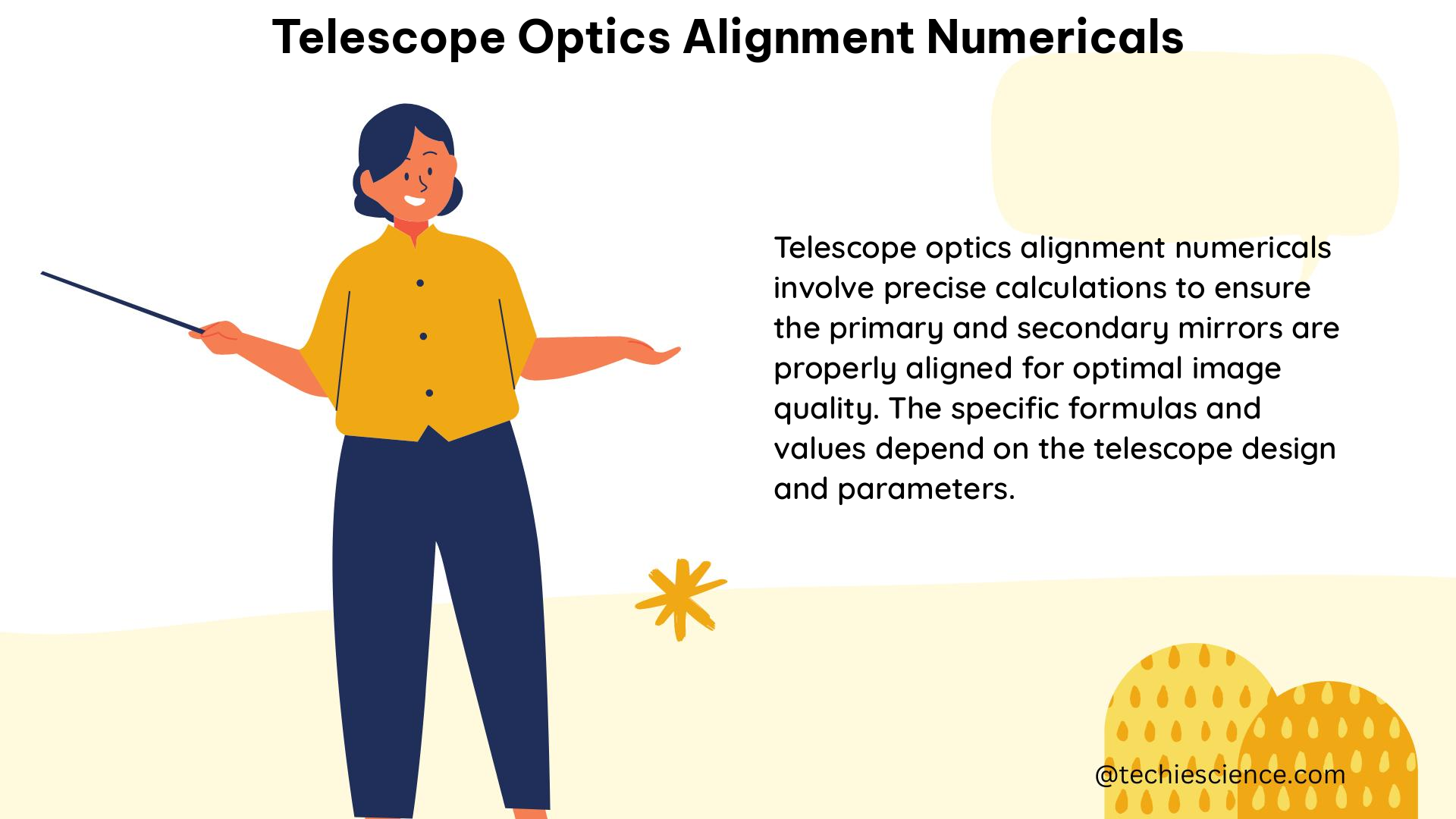Telescope optics alignment, also known as collimation, is the process of precisely adjusting the mirrors and lenses in a telescope to ensure the optical path is accurately aligned. This is a crucial step in optimizing the performance of a telescope, as it allows for the production of clear, focused images. In this comprehensive guide, we will delve into the physics behind telescope optics alignment, provide detailed examples, solve numerical problems, and explore the theoretical explanations behind aberrations in telescope optics.
Physics behind Telescope Optics Alignment
The physics behind telescope optics alignment involves aligning the optical axis of each component in the telescope system. This ensures that the light entering the telescope follows a straight path through the system, resulting in a clear, focused image. The primary mirror, secondary mirror, and other optical components must be aligned accurately to achieve optimal performance.
The alignment of the optical components is crucial in minimizing various types of aberrations, such as spherical aberration, coma, astigmatism, and chromatic aberration. These aberrations can degrade the quality of the image produced by the telescope.
Example: Collimation of a Reflector Telescope

Collimating a reflector telescope involves adjusting the primary and secondary mirrors to align the optical path. This process can be carried out using a laser collimator, Cheshire eyepiece, or other specialized tools. The typical steps involved in collimating a reflector telescope are as follows:
- Measure the angle between the optical axis of the primary mirror and the optical axis of the secondary mirror using a sight tube or other tool.
- Calculate the required adjustments to the tilt and position of the secondary mirror to align the optical path.
- Adjust the secondary mirror accordingly, ensuring that the optical path is aligned.
- Repeat the process until the optical path is accurately aligned.
Numerical Problem: Calculating the Required Adjustments for Collimation
To calculate the required adjustments for collimation, we need to measure the angle between the optical axis of the primary mirror and the optical axis of the secondary mirror. Let’s consider an example:
Suppose the angle between the optical axes is measured to be 1 degree. To align the optical path, we need to adjust the tilt of the secondary mirror.
Using the formula:
Δθ = (θ1 – θ2) / 2
Where:
– Δθ is the required adjustment in tilt
– θ1 is the measured angle between the optical axes (1 degree)
– θ2 is the desired angle between the optical axes (typically 0 degrees)
Plugging in the values, we get:
Δθ = (1 degree – 0 degree) / 2 = 0.5 degrees
Therefore, to align the optical path, we need to adjust the tilt of the secondary mirror by 0.5 degrees.
Figure: Optical Path in a Reflector Telescope

Figure 1 illustrates the optical path in a reflector telescope, with the primary and secondary mirrors aligned accurately.
Theoretical Explanation: Aberrations in Telescope Optics
Aberrations in telescope optics can degrade the quality of the image produced by the telescope. There are two main types of aberrations:
-
Monochromatic Aberrations: These occur when the optical system fails to bring all the light of a single wavelength to a single focus. Examples include spherical aberration, coma, and astigmatism.
-
Chromatic Aberrations: These occur when the optical system fails to bring all the wavelengths of light to a single focus. This results in the appearance of colored fringes around objects in the image.
Collimation is crucial for minimizing these aberrations in telescope optics. By aligning the optical path accurately, you can reduce the impact of spherical aberration, coma, astigmatism, and other aberrations, leading to a higher-quality image.
Numerical Example: Calculating Spherical Aberration
Consider a reflector telescope with a primary mirror of diameter D = 20 cm and a focal length of F = 2 m. The spherical aberration of the primary mirror can be calculated using the formula:
Spherical Aberration (SA) = (1/2) * (D^4 / F^3)
Plugging in the values:
SA = (1/2) * (20 cm)^4 / (200 cm)^3 = 0.0025 cm
This means that the light rays passing through the outer regions of the primary mirror will not focus at the same point as the light rays passing through the center, resulting in a blurred image. Collimation is necessary to minimize this spherical aberration and improve the telescope’s performance.
Reference:
- How to Check and Fix Telescope Collimation in the Field
- Optical Telescope Element Design, Development, and Performance
- Optics technology for large-aperture space telescopes
- SJ6.pdf – Lehman College
- I. The Euclid Wide Survey | Astronomy & Astrophysics (A&A)

The lambdageeks.com Core SME Team is a group of experienced subject matter experts from diverse scientific and technical fields including Physics, Chemistry, Technology,Electronics & Electrical Engineering, Automotive, Mechanical Engineering. Our team collaborates to create high-quality, well-researched articles on a wide range of science and technology topics for the lambdageeks.com website.
All Our Senior SME are having more than 7 Years of experience in the respective fields . They are either Working Industry Professionals or assocaited With different Universities. Refer Our Authors Page to get to know About our Core SMEs.